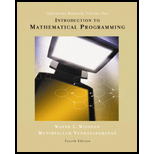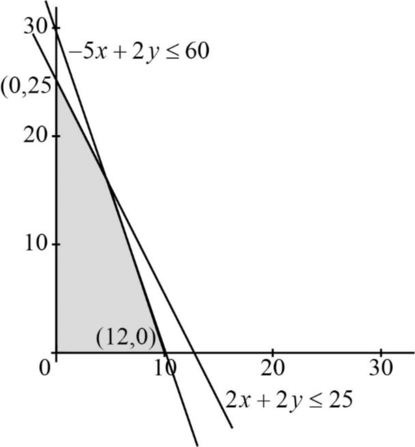
Introduction to mathematical programming
4th Edition
ISBN: 9780534359645
Author: Jeffrey B. Goldberg
Publisher: Cengage Learning
expand_more
expand_more
format_list_bulleted
Question
Chapter 3, Problem 1RP
Program Plan Intro
Linear
- The linear programming(LP) is also known as linear optimization.
- Consider a mathematical model, and its requirements are used to represent by the linear relationships. The linear programming is the best method to achieve the best outcome of this mathematical model. The outcomes may be, maximum profit or lower cost.
- The linear optimization is also called as mathematical optimization because, it is a special case of mathematical programming.
- More formally, the LP is a technique for optimizing linear objective function subject to constraints of linear equality and linear inequality.
Expert Solution & Answer
Explanation of Solution
Linear programming for solving the problem:
Let
Then,
Explanation:
- The above programming statements are used to solve the beer and ale problem. In this there are two variables “x” and “y” used to represent the barrels of beer produced and barrels of ale produced respectively.
- The above statements give the formula to maximize the profit. Which is “5x + 2y”.
Solving LP graphically:
| Beer | Ale | Total | |
| Corn | 5lb | 2lb | 60 |
| Hopes | 2lb | 1lb | 25 |
Let
LP graph:

Vertices are,
Profit function:
The profit function at
The profit function at
The profit function at
The profit is maximized at the points,
That is 10 barrels of beer and 5 barrels of ale.
Want to see more full solutions like this?
Subscribe now to access step-by-step solutions to millions of textbook problems written by subject matter experts!
Students have asked these similar questions
This battle room is focused on entry level tasks for a network analyst where you will be given trials and reconnaissance, sensor tuning, log aggregation, SIEM queries, and network analysis.
For this week’s project, complete the following tasks:
From your Project Ares portal, LOG IN
Click on LAUNCH GAME.
Select the region NORTH AMERICA
Click on Battle School
Under the BATTLE SCHOOL pop-up window, click on START TRAINING.
Under the BATTLE ROOMS tile, click on ENTER.
Under the NETWORK ANALYST tile, click on PLAY.
Wait for the Battle Room to load. While loading, the BATTLE ROOM button will display red. Once the Battle Room is loaded, the BATTLE ROOM button will turn yellow and the center of the disk display will indicate CONNECTED. Click on the BATTLE ROOM button to enter the Battle Room.
Below the TASKS folder, make sure you click on INSTRUCTIONS to download the Network Analyst Fundamentals material.
In the Battle Room, under the TASKS menu select task INTRUSION DETECTION.
Complete…
Create a relationship between the common field (Technician Number) of the two tables. Make sure that each client must have 1 and only 1 technician assigned, and each technician can have multiple clients.
2. Create a query to show the Client Number, Client Name, Billed, Paid for clients in Anderson city. Save the query.
3. Create a query to show the Technician Number, Last Name, First Name, YTD Earnings for technicians whose Hourly Rate is greater than or equal to 30. Save the query.
4. Create a query to show Client Number, Client Name, Billed, Paid for clients whose technician number is 22 and whose Billed is over 300. Save the query.
5. Create a query to show the Technician Number, Last Name, First Name, Client Number, Client Name for clients whose technician number 23. Save the query.
6. Create a query to show the Technician Number, Last Name, First Name, Client Number, Client Name for clients whose technician number 23 or 29. Save the query Help please Microsoft office access
Dijkstra's Algorithm (part 1). Consider the network shown below, and Dijkstra’s link-state algorithm. Here, we are interested in computing the least cost path from node E (note: the start node here is E) to all other nodes using Dijkstra's algorithm. Using the algorithm statement used in the textbook and its visual representation, complete the "Step 0" row in the table below showing the link state algorithm’s execution by matching the table entries (i), (ii), (iii), and (iv) with their values. Write down your final [correct] answer, as you‘ll need it for the next question.
Chapter 3 Solutions
Introduction to mathematical programming
Ch. 3.1 - Prob. 1PCh. 3.1 - Prob. 2PCh. 3.1 - Prob. 3PCh. 3.1 - Prob. 4PCh. 3.1 - Prob. 5PCh. 3.2 - Prob. 1PCh. 3.2 - Prob. 2PCh. 3.2 - Prob. 3PCh. 3.2 - Prob. 4PCh. 3.2 - Prob. 5P
Ch. 3.2 - Prob. 6PCh. 3.3 - Prob. 1PCh. 3.3 - Prob. 2PCh. 3.3 - Prob. 3PCh. 3.3 - Prob. 4PCh. 3.3 - Prob. 5PCh. 3.3 - Prob. 6PCh. 3.3 - Prob. 7PCh. 3.3 - Prob. 8PCh. 3.3 - Prob. 9PCh. 3.3 - Prob. 10PCh. 3.4 - Prob. 1PCh. 3.4 - Prob. 2PCh. 3.4 - Prob. 3PCh. 3.4 - Prob. 4PCh. 3.5 - Prob. 1PCh. 3.5 - Prob. 2PCh. 3.5 - Prob. 3PCh. 3.5 - Prob. 4PCh. 3.5 - Prob. 5PCh. 3.5 - Prob. 6PCh. 3.5 - Prob. 7PCh. 3.6 - Prob. 1PCh. 3.6 - Prob. 2PCh. 3.6 - Prob. 3PCh. 3.6 - Prob. 4PCh. 3.6 - Prob. 5PCh. 3.7 - Prob. 1PCh. 3.8 - Prob. 1PCh. 3.8 - Prob. 2PCh. 3.8 - Prob. 3PCh. 3.8 - Prob. 4PCh. 3.8 - Prob. 5PCh. 3.8 - Prob. 6PCh. 3.8 - Prob. 7PCh. 3.8 - Prob. 8PCh. 3.8 - Prob. 9PCh. 3.8 - Prob. 10PCh. 3.8 - Prob. 11PCh. 3.8 - Prob. 12PCh. 3.8 - Prob. 13PCh. 3.8 - Prob. 14PCh. 3.9 - Prob. 1PCh. 3.9 - Prob. 2PCh. 3.9 - Prob. 3PCh. 3.9 - Prob. 4PCh. 3.9 - Prob. 5PCh. 3.9 - Prob. 6PCh. 3.9 - Prob. 7PCh. 3.9 - Prob. 8PCh. 3.9 - Prob. 9PCh. 3.9 - Prob. 10PCh. 3.9 - Prob. 11PCh. 3.9 - Prob. 12PCh. 3.9 - Prob. 13PCh. 3.9 - Prob. 14PCh. 3.10 - Prob. 1PCh. 3.10 - Prob. 2PCh. 3.10 - Prob. 3PCh. 3.10 - Prob. 4PCh. 3.10 - Prob. 5PCh. 3.10 - Prob. 6PCh. 3.10 - Prob. 7PCh. 3.10 - Prob. 8PCh. 3.10 - Prob. 9PCh. 3.11 - Prob. 1PCh. 3.11 - Show that Fincos objective function may also be...Ch. 3.11 - Prob. 3PCh. 3.11 - Prob. 4PCh. 3.11 - Prob. 7PCh. 3.11 - Prob. 8PCh. 3.11 - Prob. 9PCh. 3.12 - Prob. 2PCh. 3.12 - Prob. 3PCh. 3.12 - Prob. 4PCh. 3 - Prob. 1RPCh. 3 - Prob. 2RPCh. 3 - Prob. 3RPCh. 3 - Prob. 4RPCh. 3 - Prob. 5RPCh. 3 - Prob. 6RPCh. 3 - Prob. 7RPCh. 3 - Prob. 8RPCh. 3 - Prob. 9RPCh. 3 - Prob. 10RPCh. 3 - Prob. 11RPCh. 3 - Prob. 12RPCh. 3 - Prob. 13RPCh. 3 - Prob. 14RPCh. 3 - Prob. 15RPCh. 3 - Prob. 16RPCh. 3 - Prob. 17RPCh. 3 - Prob. 18RPCh. 3 - Prob. 19RPCh. 3 - Prob. 20RPCh. 3 - Prob. 21RPCh. 3 - Prob. 22RPCh. 3 - Prob. 23RPCh. 3 - Prob. 24RPCh. 3 - Prob. 25RPCh. 3 - Prob. 26RPCh. 3 - Prob. 27RPCh. 3 - Prob. 28RPCh. 3 - Prob. 29RPCh. 3 - Prob. 30RPCh. 3 - Prob. 31RPCh. 3 - Prob. 32RPCh. 3 - Prob. 33RPCh. 3 - Prob. 34RPCh. 3 - Prob. 35RPCh. 3 - Prob. 36RPCh. 3 - Prob. 37RPCh. 3 - Prob. 38RPCh. 3 - Prob. 39RPCh. 3 - Prob. 40RPCh. 3 - Prob. 41RPCh. 3 - Prob. 42RPCh. 3 - Prob. 43RPCh. 3 - Prob. 44RPCh. 3 - Prob. 45RPCh. 3 - Prob. 46RPCh. 3 - Prob. 47RPCh. 3 - Prob. 48RPCh. 3 - Prob. 49RPCh. 3 - Prob. 50RPCh. 3 - Prob. 51RPCh. 3 - Prob. 52RPCh. 3 - Prob. 53RPCh. 3 - Prob. 54RPCh. 3 - Prob. 56RPCh. 3 - Prob. 57RPCh. 3 - Prob. 58RPCh. 3 - Prob. 59RPCh. 3 - Prob. 60RPCh. 3 - Prob. 61RPCh. 3 - Prob. 62RPCh. 3 - Prob. 63RP
Knowledge Booster
Similar questions
arrow_back_ios
SEE MORE QUESTIONS
arrow_forward_ios
Recommended textbooks for you
 Operations Research : Applications and AlgorithmsComputer ScienceISBN:9780534380588Author:Wayne L. WinstonPublisher:Brooks Cole
Operations Research : Applications and AlgorithmsComputer ScienceISBN:9780534380588Author:Wayne L. WinstonPublisher:Brooks Cole

Operations Research : Applications and Algorithms
Computer Science
ISBN:9780534380588
Author:Wayne L. Winston
Publisher:Brooks Cole